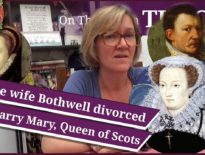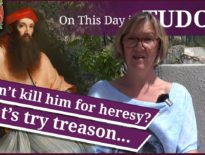On this day in Tudor history, 6th May 1502, in the reign of King Henry VII, Sir James Tyrell, former royal councillor, was executed for treason due to his links to a known traitor.
But it's not for his time as a trusted councillor, or for his links to a claimant to the throne that he is known, but for his alleged involvement in the murders of the Princes in the Tower.
Find out more in today's talk.
You can find out more about claimant Edmund de la Pole, the man Tyrell was meant to be connected with, in the 4th May video from last year:
Also on this day in Tudor history, 6th May 1541, King Henry VIII issued an injunction ordering the Great Bible to be available in every church in England. I explain more in last year's video:
And in the video for the 6th May 1536, I talk about a letter linked to Anne Boleyn, a letter with the title “To the King from the Lady in the Tower”.
Also on this day in history:
- 1471 – Execution of Edmund Beaufort, styled 3rd Duke of Somerset, in Tewkesbury market place. He had headed Margaret of Anjou's troops at the Battle of Tewkesbury, and after their defeat had tried to take sanctuary at Tewkesbury Abbey. Edward IV broke into the abbey and captured him.
- 1527 – The Sack of Rome. Rome was attacked and looted by mutinous imperial troops. Pope Clement VII managed to escape, but the majority of the Swiss Guard were killed.
- 1540 – Death of Juan Luis Vives, scholar, at Bruges. Tudor history lovers know him for being a friend and spiritual adviser to Catherine of Aragon and a tutor to Princess Mary. He wrote a treatise, “Education of a Christian Woman”, with Catherine's encouragement, and also wrote Satellitium animi, or “Escort of the Soul”, a plan of study for Mary.
- 1563 – Burial of Henry Stafford, 10th Baron Stafford, in Worthen Church near Caus Castle in Shropshire.
Transcript:
On this day in Tudor history, 6th May 1502, in the reign of King Henry VII, Sir James Tyrell, former royal councillor, was executed for treason. Interestingly, it is his link to the Princes in the Tower for which he is known.
Let me give you an overview of Sir James Tyrell’s life and explain how he came to be executed and how he’s linked to Edward IV’s sons.
• Sir James Tyrell was born in around 1455 and was the eldest son of William Tyrell of Gipping in Suffolk and his wife, Margaret Darcy, who originated from Malden in Essex.
• James’s father, William, was executed in 1462 for plotting against King Edward IV with John de Vere, Earl of Oxford.
• James was allowed to inherit his father’s land, as his father had not been attainted, and Cecily Neville, Dowager Duchess of York and Edward IV’s mother, purchased James’s wardship.
• In 1469, when he was about 14, he married Anne Arundel, daughter of John Arundel or Lanherne, in Cornwall. They went on to have three sons and a daughter.
• In May 1471, when he was about 16, James fought at the Battle of Tewkesbury on the Yorkist side, and was knighted by Edward IV.
• In late 1471, James entered the service of Edward IV’s brother, Richard, Duke of Gloucester, the future King Richard III. He was trusted by the duke to escort the duke’s mother-in-law, the dowager countess of Warwick, north in 1473, served the duke in the 1480-82 Scottish campaign.
• In 1478, James served as knight for the shire for Cornwall and was elected for the 1483 Parliament.
• Following his patron Gloucester’s accession in 1483, James was appointed as a knight of the body and also served as Master of the Horse and Master of the Henchmen.
• In reward for helping to put down the Duke of Buckingham’s rebellion, he was made Steward of the Duchy of Cornwall, and he then served the king in offices in Wales.
• In January 1485, he was appointed Lieutenant of Guînes, and was there carrying out his duties when the king was defeated by Henry Tudor at the Battle of Bosworth. The new king, Henry VII, kept James on in Guînes, and James sought a pardon from Henry for himself and the garrison.
• In 1486, he served Henry VII as an ambassador and in 1488 was appointed as a knight of the body. He served as an ambassador again in 1492.
• In 1499, Yorkist claimant to the throne, Edmund de la Pole, earl of Suffolk, fled from England into exile, stopping at Guînes on the way, and seeing James. In the spring of 1502, Henry VII sent Sir Thomas Lovell to Guînes to arrest Tyrell, his son, Thomas, and several others. On 2nd May 1502, James was tried for treason at Guildhall in London and condemned to death. He was executed by beheading on Tower Hill on this day in 1502, with an associate, Sir John Wyndham, and was laid to rest in the Church of the Austin Friars, London.
• In his work “The History of King Richard III”, King Henry VIII’s Lord Chancellor, Sir Thomas More described how during his imprisonment in the Tower of London, Sir James Tyrell confessed to being involved in the murder of Edward IV’s sons, the Princes in the Tower. More wrote: “Sir James Tyrrel devised that they should be murdered in their beds” and that he appointed Miles Forest, one of four men looking after them, and John Dighton, his own horsekeeper, to do the deed. More goes on to describe how these two men wrapped the princes in their bedclothes and “entangled them”, smothering them with their featherbed and pillows. More writes of how King Richard III gave Tyrell thanks and knighted him for his service.
As Tyrell’s biographer, Rosemary Horrox points out, there is no surviving copy of any such confession from Tyrell.



A good fiction, invented to please the new Tudor regime, made by a man convicted of treason, but actually no confession has ever been found. David Starkey thinks it was genuine, but then he would.